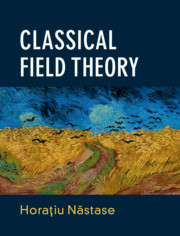Book contents
- Frontmatter
- Dedication
- Contents
- Preface
- Acknowledgements
- Introduction
- Part I General Properties of Fields; Scalars and Gauge Fields
- 1 Short Review of Classical Mechanics
- 2 Symmetries, Groups, and Lie algebras; Representations
- 3 Examples: The Rotation Group and SU(2)
- 4 Review of Special Relativity: Lorentz Tensors
- 5 Lagrangeans and the Notion of Field; Electromagnetism as a Field Theory
- 6 Scalar Field Theory, Origins, and Applications
- 7 Nonrelativistic Examples:WaterWaves and Surface Growth
- 8 Classical Integrability: Continuum Limit of Discrete, Lattice, and Spin Systems
- 9 Poisson Brackets for Field Theory and Equations of Motion: Applications
- 10 Classical Perturbation Theory and Formal Solutions to the Equations of Motion
- 11 Representations of the Lorentz Group
- 12 Statistics, Symmetry, and the Spin-Statistics Theorem
- 13 Electromagnetism and the Maxwell Equation; Abelian Vector Fields; Proca Field
- 14 The Energy-Momentum Tensor
- 15 Motion of Charged Particles and ElectromagneticWaves; Maxwell Duality
- 16 The Hopfion Solution and the Hopf Map
- 17 Complex Scalar Field and Electric Current: Gauging a Global Symmetry
- 18 The Noether Theoremand Applications
- 19 Nonrelativistic and Relativistic Fluid Dynamics: Fluid Vortices and Knots
- Part II Solitons and Topology; Non-Abelian Theory
- Part III Other Spins or Statistics; General Relativity
- References
- Index
12 - Statistics, Symmetry, and the Spin-Statistics Theorem
from Part I - General Properties of Fields; Scalars and Gauge Fields
Published online by Cambridge University Press: 04 March 2019
- Frontmatter
- Dedication
- Contents
- Preface
- Acknowledgements
- Introduction
- Part I General Properties of Fields; Scalars and Gauge Fields
- 1 Short Review of Classical Mechanics
- 2 Symmetries, Groups, and Lie algebras; Representations
- 3 Examples: The Rotation Group and SU(2)
- 4 Review of Special Relativity: Lorentz Tensors
- 5 Lagrangeans and the Notion of Field; Electromagnetism as a Field Theory
- 6 Scalar Field Theory, Origins, and Applications
- 7 Nonrelativistic Examples:WaterWaves and Surface Growth
- 8 Classical Integrability: Continuum Limit of Discrete, Lattice, and Spin Systems
- 9 Poisson Brackets for Field Theory and Equations of Motion: Applications
- 10 Classical Perturbation Theory and Formal Solutions to the Equations of Motion
- 11 Representations of the Lorentz Group
- 12 Statistics, Symmetry, and the Spin-Statistics Theorem
- 13 Electromagnetism and the Maxwell Equation; Abelian Vector Fields; Proca Field
- 14 The Energy-Momentum Tensor
- 15 Motion of Charged Particles and ElectromagneticWaves; Maxwell Duality
- 16 The Hopfion Solution and the Hopf Map
- 17 Complex Scalar Field and Electric Current: Gauging a Global Symmetry
- 18 The Noether Theoremand Applications
- 19 Nonrelativistic and Relativistic Fluid Dynamics: Fluid Vortices and Knots
- Part II Solitons and Topology; Non-Abelian Theory
- Part III Other Spins or Statistics; General Relativity
- References
- Index
Summary
We define statistics of quantum mechanical particles, obtaining the Bose–Einstein and Fermi–Dirac varieties of indistinguishable particles. After finding the rotation and Lorentz matrices in different Lorentz representations, we describe the spin-statistics theorem, relating fermions with half-integer spin and bosons with integer spin. We explain two simple proofs and say some words on two others. We end by discussing symmetries in more generality, and we discuss the fact that internal symmetries must commute with spacetime ones, due to the Coleman–Mandula theorem.
- Type
- Chapter
- Information
- Classical Field Theory , pp. 108 - 117Publisher: Cambridge University PressPrint publication year: 2019

